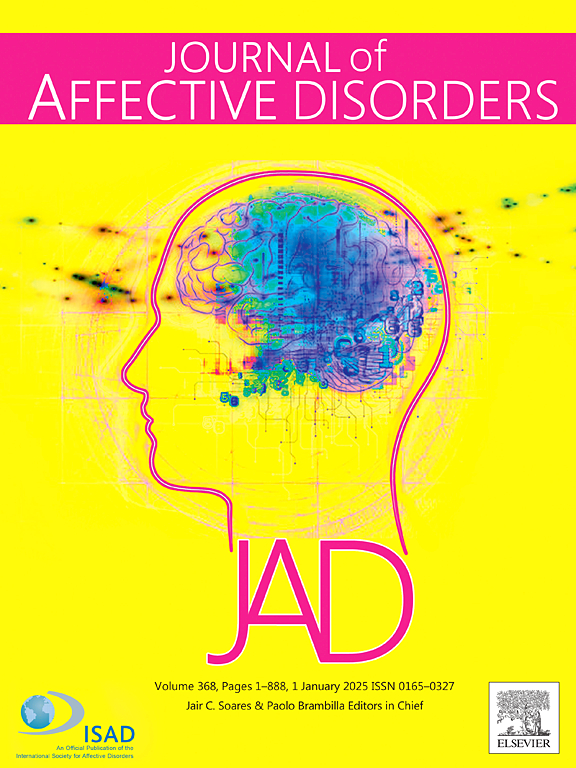双重战斗:比较患有和不患有共病饮食障碍的强迫症患者的六年病程
IF 4.9
2区 医学
Q1 CLINICAL NEUROLOGY
引用次数: 0
摘要
背景:进食障碍(ED)在强迫症(OCD)患者中更为普遍,其共存与较高的症状严重程度、增加的其他合并症(包括抑郁症)风险以及较差的治疗效果相关。然而,我们对合并ED与不合并ED患者的长期病程知之甚少。本研究调查了(OCD + ED)和(OCD-ED)终身ED患者的6年临床病程(症状严重程度)。方法在荷兰强迫症协会(NOCDA)队列中,382名诊断为DSM-IV强迫症的参与者被归类为OCD + ED (n = 46;女性占91%;平均年龄34.5岁)或OCD-ED (n = 336;女性占52%;平均年龄36.6岁)。终生ED诊断包括神经性厌食症(39%)和暴饮暴食症(37%)。强迫症和ED的诊断、症状严重程度和临床/人口学变量在基线和2年、4年和6年后进行评估。使用线性混合效应模型来检验强迫症症状轨迹的组间差异。结果与强迫症患者相比,socd + ED患者出现了更高的强迫症、抑郁和焦虑症状,并伴有更多的创伤后应激障碍。尽管存在这些差异,但两组在强迫症症状严重程度上都遵循了可比较的6年病程,在症状减轻方面组间无显著差异。强迫症患者Y-BOCS评分下降4.17分,强迫症+ ED患者Y-BOCS评分下降5.24分;PADUA分数分别下降了13.68分和15.65分。结论虽然强迫症+ ED患者表现出更显著的临床负担,但合并症ED并未显著缓解强迫症的长期症状轨迹,这表明需要更强化和/或更长时间的治疗。OCD + ED组相对较小的规模可能被认为是一种限制。本文章由计算机程序翻译,如有差异,请以英文原文为准。
The double battle: comparing the six-year course of obsessive-compulsive disorder with and without comorbid eating disorder
Background
Eating disorders (ED) are more prevalent in individuals with obsessive-compulsive disorder (OCD), and their co-occurrence is associated with higher symptom-severity, increased risk of additional comorbidities, including depression, and poorer treatment outcomes. However, little is known about the long-term course of OCD in patients with versus without comorbid ED. This study investigated the 6-year clinical course of OCD symptom-severity in patients with (OCD + ED) and without (OCD-ED) lifetime ED.
Methods
Within the Netherlands OCD Association (NOCDA) cohort, 382 participants with a DSM-IV OCD diagnosis were classified as OCD + ED (n = 46; 91 % women; mean age 34.5) or OCD-ED (n = 336; 52 % women; mean age 36.6). Lifetime ED diagnoses included anorexia nervosa (39 %) and binge-eating disorder (37 %). OCD and ED diagnoses, symptom severity, and clinical/demographic variables were assessed at baseline and after two, four, and six years. Linear mixed-effects models were used to examine group differences in OCD symptom trajectories.
Results
OCD + ED participants showed higher baseline obsessive-compulsive, depressive, and anxiety symptoms, and more comorbid posttraumatic stress disorder than OCD-ED patients. Despite these differences, both groups followed a comparable 6-year course of OCD symptom severity, with no significant between-group differences in symptom reduction. Y-BOCS scores decreased by 4.17 points in OCD-ED and 5.24 in OCD + ED; PADUA scores declined by 13.68 and 15.65 points, respectively.
Conclusion
While OCD + ED patients showed a more significant clinical burden, comorbid ED did not significantly moderate long-term OCD symptom trajectories, suggesting a need for more intensive and/or longer treatment. The relatively small size of the OCD + ED group may be considered a limitation.
求助全文
通过发布文献求助,成功后即可免费获取论文全文。
去求助
来源期刊

Journal of affective disorders
医学-精神病学
CiteScore
10.90
自引率
6.10%
发文量
1319
审稿时长
9.3 weeks
期刊介绍:
The Journal of Affective Disorders publishes papers concerned with affective disorders in the widest sense: depression, mania, mood spectrum, emotions and personality, anxiety and stress. It is interdisciplinary and aims to bring together different approaches for a diverse readership. Top quality papers will be accepted dealing with any aspect of affective disorders, including neuroimaging, cognitive neurosciences, genetics, molecular biology, experimental and clinical neurosciences, pharmacology, neuroimmunoendocrinology, intervention and treatment trials.
 求助内容:
求助内容: 应助结果提醒方式:
应助结果提醒方式:


